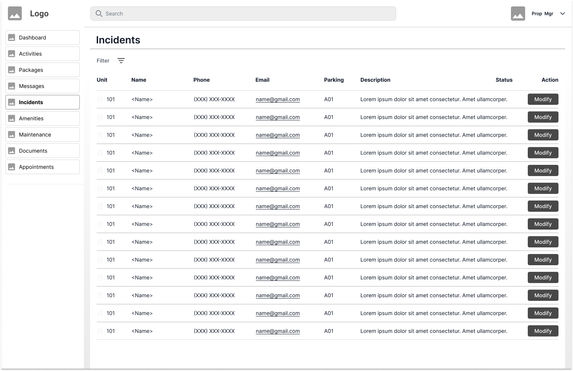
Aegis
SaaS Design and Development of Property Management Software
Aegis is a scalable application empowering condominium property managers to seamlessly track and manage property-specific activities with real-time, data-driven insights, helping to streamline operations, maximize revenue and enhance tenants' living experiences.
Project Overview
Challenge
How might we enable property managers to monitor activities and documentation for their condominiums while feeling confident in maintaining full compliance with regulatory updates?
Key Objectives
Aegis is a native application for property managers, tenants and security personnel at condominiums in the Greater Toronto Area. The goal of the application is twofold: 1) to enable property managers and front desk personnel to track activities/ updates of tenants, staff and vendors at the properties, while ensuring data security and confidentiality; and 2) to empower tenants to update and manage service bookings, packages and complaints at the premises.
My Role: UX Designer
Contributions
My work on the project began by revisiting an existing (prototype) design and outlining the product strategy for the Aegis app. I reconceptualized the design, ideating and building a more streamlined interface with optimized information architecture/ navigation and appealing visuals. While crafting the desktop interface (for usage at the front desk), I also proposed a mobile app for tracking the activities of tenants and property managers.
Team size: 8
Product Owner (1), Project Manager (1), Marketing (2), UX Designer (1), Developers (3)
Tools
Figma | Adobe Creative Suite | Miro | Whimsical

Solution
From research and ideation to UI and implementation, I designed Aegis to allow users to view and manage summaries / updates of activities at condo premises, including tenants, security personnel and vendors.
Examples of data to be managed by Aegis:
-
Tenant details and communication logs
-
Facility/ service management (bookings, etc.)
-
Payment records (due dates, billing history, etc.)
-
Repairs and maintenance records
-
Document management
-
Facility management (AGMs, etc.)
Approach
01
Design Discovery
02
Solution Roadmap
03
Ideation & Wireframing
04
Prototyping
05
Testing & Implementation

01
Design Discovery
Secondary & Primary Research
My professional experience of analyzing market positioning and evaluating SWOT and competitor analysis helped in laying the foundation for the secondary research. In-depth in-person interviews and observational inquiries led a pathway through my primary research.
Research Goal
To develop an understanding of the property management software market, discover the target audience, identify the user groups' behavior and journey when using property-tracking applications, and, finally, understand the successes and failures of competitor applications.
Market Analysis
The Canadian property management market is demonstrating robust growth with CAGR of 7%, further fueled in part by new technologies and software adopted to streamline operations and increase efficiency.
Source: Property Management in Canada Market Overview 2023-2027.

Global Property Management Software Market Size (2022 - 2030) - CAGR 9.7%
MARKET SIZE (2023): USD 7.93 BILLION
END USER SEGMENTATION: PROPERTY MANAGERS (37.9%)
Other users of the software include Housing Associations, Real Estate Agents, and others.
60% CLOUD-BASED APPLICATIONS, REST ON-PREMISES
Source: Fortune Business Insights
Competitive Analysis

User Interviews
Research Approach
As UX Designer, I also played a dual role as UX Researcher, planning and conducting interviews with a total of 40 respondents to unearth insights on certain aspects of the product, including but not limited to:
Navigation | Service Bookings | Stakeholder Updates | Real-Time Monitoring | Data Security
Sampling Method
Convenience, Purposive, Snowball
Sample
Size
40
Target
Users
Property Managers, Building Security Personnel, Tenants
Data Collection
In-depth interviews (using semi-structured questionnaire) and real-time software walkthrough


Empathy Mapping
Overall, there is considerable potential for conceptualization and problem-solving in the condominium property management software space, with ample space for scalability. Although, maybe the right questions haven’t been asked and not enough problems solved thus far within this growing market.


02
Solution Roadmap
Problem Statement
"
Property managers need a way to quickly and easily access real-time data about maintenance requests, tenant communication, and compliance updates because they are finding competitors' software too complex to navigate and thus incurring high costs on training staff on using the software.
"
Value Proposition
Product Goals (features)
-
A customizable dashboard providing quick access and alerts to critical metrics, reports, and tasks
-
A streamlined payment automation mechanism for managing rent payments, recurring billing, late fees, and reminders
-
Integrated communication tools such as instant messaging, email integration, and push notifications
-
Real-time maintenance updates to monitor work orders, contractor assignments, and work completion status
-
Secure document management repository assisted by notifications for regulatory compliance (lease renewals, inspections, etc.)
-
Cloud-based real-time reporting and alerts for quick responses to tenant/ vendor requests
-
Exhaustive stakeholder directory for tenants, security personnel, and vendors (contact details, in/out times, service requests, etc.)
-
Mobile Accessibility: A mobile app for property managers and tenants to access key features on-the-go.
Pain Relievers (addressing users' pain points)
A unified platform for managing all communications, including a comprehensive directory for emergencies and one-dial call/ response.
-
[Pain point addressed: "There's usually such a massive number of complaints (repairs, maintenance, etc.) that it's not always possible for us to handle things by ourselves. And we don't always have instant access to a technician during emergencies or late hours."]
Automated tracking (including alerts) on regulatory / compliance updates including documentation, meetings etc.
-
[Pain point addressed: "Amidst such a high volume of daily tasks, I often lose track of time to update or submit documentation in compliance with regulatory guidelines..."]
Comprehensive integration of finance management, reporting and communication tools
-
[Pain point addressed: "(continuation of the above pain point)... part of this is because my portal does not alert me ahead of time, and I can only get the alerts from the portal as it's not connected to my Google Calendar or Outlook."]
Gain Creators
Increased efficiency through automation and integration
-
[Pain point addressed: "We are facing issues in integrating our software (AppFolio) with specialized accounting or CRM tools. As a result, additional costs are incurred as we have to train our concierge and security staff on how to manually transfer data between systems."]
Seamless payment options and communication channels connecting property managers to tenants, staff and vendors
Scalability to accommodate a wider range of automated tasks across multiple properties
Real-time access to financial and operational reports
Device compatibility including smartphones and tablets enabling remote task management
-
[Pain point addressed: "(Apps such as) the Condo Control mobile app are not reliable or comprehensive as the desktop interface, especially for property managers like myself who need round-the-clock access and updates while on-site or traveling."]
Product Strategy
The project has 4 phases in total, starting with a local-access SaaS platform for property managers and site security personnel. This is the stage at which the project currently stands.
The product is to be scaled up for additional user groups (tenants) and devices (smartphones and tablets), parallel to which an AI asset will be integrated for streamlining the data feed, information retrieval, and access control.
Information Architecture
How Might We?
To create the digital solution, I first acknowledged business aims and necessary features for user goals and then formulated a main architectural plan that would accomplish the goals for the minimum viable product.
To develop the prime architectural goals, I formulated a series of How Might We statements.
-
How might we help property managers seamlessly monitor service requests and maintenance work updates?
-
How might we create for users a more accessible and usable document management experience?
-
How might we enable tenants to easily establish contact with property managers, security staff, maintenance vendors, and emergency responders?
User Flows
To create the digital solution, I first acknowledged business aims and necessary features for user goals and then formulated a main architectural plan that would accomplish the goals for the minimum viable product.

This is one key user flow, after which I created a detailed sitemap and information architecture for the MVP, with a SiteFlow technique for each individual task.

03
Ideation & Wireframing
Brainstorming
The brainstorming phase involved hundreds of PostIt notes, whiteboards and markers, using which my team and I conceptualized ideas to solve the user challenges identified above and prioritized the ideas to start developing wireframes. The goal was to arrive at a design that would align with business goals as well as iteratively build towards a product delivering superior user experience and set itself apart from competitors.
Braindumping
After researching and analyzing design patterns that fit the information architecture, business goals, and user needs, I sketched solutions. Using rapid-prototyping and Figma to move forward thoughts and ideas, I focused mainly on meeting the How Might We in an iterative approach.
Making sure I met WCAG 2.0 accessibility guidelines, I from sketches to wireframing solutions and screens via Figma.

Wireframing
After researching and analyzing design patterns that fit the information architecture, business goals, and user needs, I sketched solutions. Using rapid-prototyping and Figma to move forward thoughts and ideas, I focused mainly on meeting the How Might We in an iterative approach.
Making sure I met WCAG 2.0 accessibility guidelines, I from sketches to wireframing solutions and screens via Figma.


Usability Testing (Mockups)
Prior to building the high-fidelity prototype, I wrote and proposed a Usability Test Guide to evaluate the mockups. I selected a total of 10 participants including property managers and security staff (condominium concierge) to participate virtually in a Microsoft Teams usability test.
Participant Pool
Tasks
A total of 5 tasks were created to test the usability and critical objectives of the application:
-
Entering a new user profile in the Directory
-
Alerting a vendor about an incident report
-
Booking a maintenance service on an amenity (e.g., elevator repair)
-
Create a Pass-On / Relay log to delegate tasks to the security personnel taking over the next shift
-
Accessing the user's profile to change display settings
Summary of Feedback
“The dashboard could use a visual representation of data (charts, graphs, etc.)."
-
Participant on Dashboard.
“I like the listing of the incident reports and call to action. I think the page could add some additional calls to action or buttons such as Create New Incident to add new reports, and/ or Contact Vendor to send a direct alert for immediate response."
"The timeline format is helpful in understanding where actioning on the incident report stands, and whether any further action is warranted."
-
Participant on Incident Reports.
“It's fairly straightforward. I don't think any changes are needed here."
-
Participant on adding a new user profile to the Directory.


04
Prototyping
Design System
UI Toolkit

Prototype (Interactions)
UI Toolkit

UI Design

Usability Testing (Prototype)
I used the Usability Test Guide developed earlier to evaluate the prototypes. The participant pool for the prototype usability test was of a similar composition as the Mockup usability test.
A total of 10 participants were selected, including property managers and security staff, to navigate the prototype and share their feedback virtually over Microsoft Teams.
Participant Pool
Tasks
The same 5 tasks were given to the participants to test the usability of the application:
-
Entering a new user profile in the Directory
-
Alerting a vendor about an incident report
-
Booking a maintenance service on an amenity (e.g., elevator repair)
-
Create a Pass-On / Relay log to delegate tasks to the security personnel taking over the next shift
-
Accessing the user's profile to change display settings
Test Goals
-
To identify any critical errors or incomplete task flows
-
To evaluate any potential challenges faced in navigation or design
-
To understand successful task flows and identify helpful UI features
-
To assess the placement and correctness of content
Summary of Feedback
“The Incident Reports page looks good. It's easy to navigate and understand the action flow."
"The timeline format is really helpful in understanding the progress on a complaint or a service request."
-
Participant on Incident Reports.
“The Directory looks good. It's easy to navigate and update."
-
Participant on adding a new user profile to the Directory.
“The multiple View options of Amenities is great! It avoids monotony. I was able to book an Elevator Servicing using the Calendar."
-
Participant on booking a new service request using the Calendar feature of Amenities."
“Having multiple Tabs on the navigation for Security Logs and Pass-On Logs makes it easy to understand where I would have to go to create or update relay logs."
-
Participant on Pass-On Logs."
Wins
All participants asserted that the MVP would meet their individual and business goals.
They also shared some interesting suggestions:
-
Add Ai-enabled document management (issuance and tracking).
-
Enable tracking incident alerts for multiple properties by using a Toggle feature.
-
Add a Chatbot to connect with Customer Service or find instant help for FAQ.


Aegis Design Evolution


05
Test & Implementation

Key Takeaways
Streamlining the Design
01
Accessibility Compliance
The app content was designed and implemented in full compliance with accessibility guidelines (WCAG), including font size, color contrast, content loading, and responsiveness.
03
Information Architecture Overhaul
To streamline the IA, the global navigation bar was redesigned optimizing the number of tabs; additionally, tabs were added for easily switching views between tenants, property staff and external vendors. The IA and user flows were redefined through iterative design.
02
CMS Integration
The application is to integrate in the back-end with specialized accounting or other CRM tools such as calendars, etc. to seamlessly share and track data from other applications, as well as to save overhead costs.
04
Scalability
Additional features such as user authentication, user profile pages, integration with notification generation platforms (e.g., SMS and email), and AI chatbot interface for instant support will be incorporated in the design. Additionally, the application will factor in for real-time data feed from multiple properties owned / operated by an individual / group.

Way Forward
-
Following the MVP launch and recursive testing, I will work further on enhancing the tenant-end of the desktop application as well as crafting a mobile-friendly interface (for smartphone and tablet access).
-
I will design a website in coordination with the Marketing team, which will be used to pitch the product(s) to a wider target audience base.
-
Map a User Experience Journey for a more concrete understanding of users' emotions and challenges when building towards finer iterations.
-
I am working with the product team to conceptualize and integrate an AI toolkit to drive the application and automate tasks, such as document generation/ issuance, storage and management. This includes notifying users ahead of time on document expiry or regulatory updates.



























